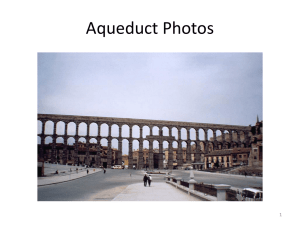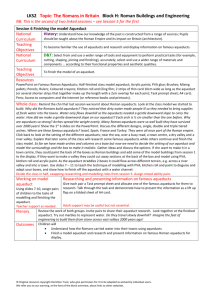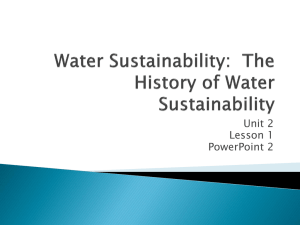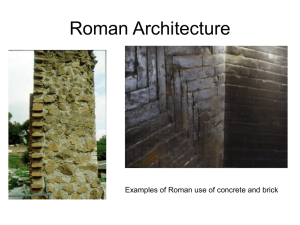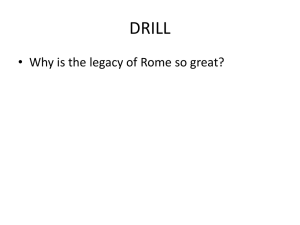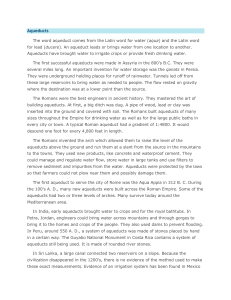roman aqueducts
advertisement
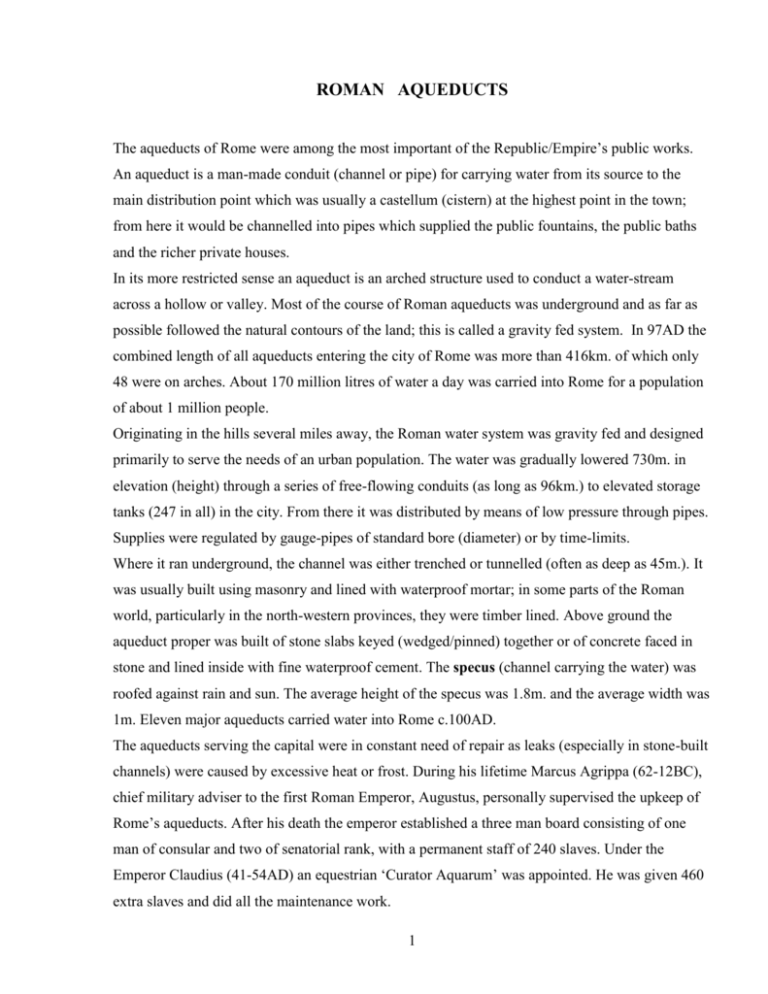
ROMAN AQUEDUCTS The aqueducts of Rome were among the most important of the Republic/Empire’s public works. An aqueduct is a man-made conduit (channel or pipe) for carrying water from its source to the main distribution point which was usually a castellum (cistern) at the highest point in the town; from here it would be channelled into pipes which supplied the public fountains, the public baths and the richer private houses. In its more restricted sense an aqueduct is an arched structure used to conduct a water-stream across a hollow or valley. Most of the course of Roman aqueducts was underground and as far as possible followed the natural contours of the land; this is called a gravity fed system. In 97AD the combined length of all aqueducts entering the city of Rome was more than 416km. of which only 48 were on arches. About 170 million litres of water a day was carried into Rome for a population of about 1 million people. Originating in the hills several miles away, the Roman water system was gravity fed and designed primarily to serve the needs of an urban population. The water was gradually lowered 730m. in elevation (height) through a series of free-flowing conduits (as long as 96km.) to elevated storage tanks (247 in all) in the city. From there it was distributed by means of low pressure through pipes. Supplies were regulated by gauge-pipes of standard bore (diameter) or by time-limits. Where it ran underground, the channel was either trenched or tunnelled (often as deep as 45m.). It was usually built using masonry and lined with waterproof mortar; in some parts of the Roman world, particularly in the north-western provinces, they were timber lined. Above ground the aqueduct proper was built of stone slabs keyed (wedged/pinned) together or of concrete faced in stone and lined inside with fine waterproof cement. The specus (channel carrying the water) was roofed against rain and sun. The average height of the specus was 1.8m. and the average width was 1m. Eleven major aqueducts carried water into Rome c.100AD. The aqueducts serving the capital were in constant need of repair as leaks (especially in stone-built channels) were caused by excessive heat or frost. During his lifetime Marcus Agrippa (62-12BC), chief military adviser to the first Roman Emperor, Augustus, personally supervised the upkeep of Rome’s aqueducts. After his death the emperor established a three man board consisting of one man of consular and two of senatorial rank, with a permanent staff of 240 slaves. Under the Emperor Claudius (41-54AD) an equestrian ‘Curator Aquarum’ was appointed. He was given 460 extra slaves and did all the maintenance work. 1 The water had to arrive at the town at a high level in order to serve the higher parts of town. The longest known aqueduct was at Roman Carthage with a channel length of 132km., but lengths of 80km. or 90km. were common. If the population of a town increased, the answer was to build a new aqueduct rather than amend an existing one. The entire aqueduct had to run downhill, so the source was usually very high. This meant that it was often in the mountains and so there were often valleys to be negotiated. In this case, the engineer had three choices: 1. Contour around the valley which was simple if the valley was short. Maintenance costs of Roman aqueducts were very high as the water was very hard and left a deposit which blocked the channel if it was not cleared out often. For this reason the engineer would want the aqueduct to be as short as possible. 2. The engineer could cross the valley using an inverted siphon (this worked much like siphoning petrol). However, siphons were expensive probably because of the cost of lead and its transportation to make the pipes. 3. Usually the choice was a bridge composed of a row of arches such as the Pont du Gard. This system could be used provided that the bridge was no more than 50m. high; otherwise the inverted siphon had to be used. Of the more than 200 aqueducts still extant (in existence) throughout what was once the Roman Empire, the best known is the exceptionally well preserved Pont du Gard. The bridge is 275m. long and 49m. high. It is part of an aqueduct nearly 50km. long which carried water from springs to Nemausus (Nîmes) and which was mainly trenched in the ground. The first level of the bridge carried a road built in the Napoleonic era. On the top of the third level it carried a water conduit or specus 1.8m. in height and 1m. in width. The gradient was 0.4%. The three levels were built in dressed limestone without mortar. Each span is composed of a number of parallel arches (four in the lowest range, three in the second and one in the third) which are simply juxtaposed (placed beside each other) without interlocking. It was reputedly built by Marcus Agrippa c.20-16BC. The lowest level has 6 arches, the middle level 11 arches and the top most level 35 arches. The bridge is slightly curved against the flow of the stream. “Here we have the apotheosis (highest development) of the arch, used with the functional good taste which was a Roman gift and elevated engineering to the level of an art.” (Wheeler p.149. 2 Another spectacular example of Roman architecture and engineering is the section of the Spanish aqueduct at Segovia in Spain built c.100-110AD during the reign of the Emperor Trajan. The conduit or specus is carried across the centre of the city on two storeys of 128 arches, each one resting on slender piers. These piers consist of roughly squared granite stone blocks, the ones on the taller, thicker arches on ground level weighing as much as 50 tonnes each. All the blocks in the structure rest firmly upon one another without lime mortar or cement. The aqueduct is 110m. long and rises to 36m. at its highest point. These huge structures were as much symbols of power as they were functional necessities. One can only imagine what a tribal Gaul or German would think when faced with the majesty of the Pont du Gard. Any empire which could construct such enormous structures was deserving of respect. The building of such structures is in keeping with other strategies of control in conquered areas. Functional symbols of power and strength were constructed everywhere. The luxuries of Rome were fast tracked into the new provinces so at least the power brokers in the area could experience what it was like to live as a Roman. When they experienced running water, bath houses, wine, circuses and gladiatorial contests would they want to return to their older, and from a Roman point of view, more barbarian way of life? The central paradox of the aqueducts as one of the most lovely and enduring of Roman monuments is that they would generally have been seen by only very few people as they are mostly in remote places. Also they could technically have been replaced by siphons which were too expensive so the magnificent bridges are a ‘monument to cheapness’. Another drawback was that they often had running repairs and looked rather untidy; even the Pont du Gard has some roughly cut and protruding stones which served as supports for wooden scaffolding. But it has to be said that that the bridges are magnificent, imposing and aesthetically pleasing, an enduring monument to Roman engineering efficiency. 3
